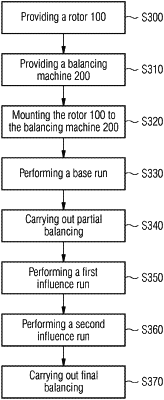| CPC G01M 1/32 (2013.01) [G01M 1/02 (2013.01); G01M 1/22 (2013.01); G06F 17/11 (2013.01); G06F 17/16 (2013.01); G06F 17/18 (2013.01); G01M 15/14 (2013.01)] | 11 Claims |

|
1. A rotor balancing method for a gas turbine, the method comprising:
providing a rotor comprising: a first bearing and a second bearing, and a plurality of correction planes comprising a first correction plane and a second correction plane;
mounting the rotor for balancing by receiving the first bearing on a first pedestal and the second bearing on a second pedestal;
performing a base run by: running the rotor at an intended balance speed and measuring vibrations at the first pedestal;
carrying out partial balancing and a first influence run of the rotor by: fitting a first balancing weight to the first correction plane in order to reduce vibrations at the first pedestal, running the rotor at the intended balance speed and measuring the vibrations at the first pedestal and the second pedestal; leaving the first balancing weight fitted for all following influence runs;
performing a second influence run by: fitting a first calibration weight to the second correction plane, running the rotor at the intended balance speed and measuring the vibrations at the first pedestal and the second pedestal, and removing the first calibration weight;
carrying out final balancing of the rotor by: fitting a final balancing weight to the first correction plane and a second balancing weight to the second correction plane dependent on the vibrations measured as part of the first influence run and the second influence run;
providing a data set containing: reference vibration measurements taken during balancing of at least one reference rotor that is the same as the rotor, or at least a first reference influence vector of the first correction plane, wherein the reference influence vector is an influence vector of the first correction plane of the at least one reference rotor:
wherein fitting the first balancing weight comprises using the data set to determine a mass and an angular position of the first balancing weight to reduce vibrations at the first pedestal;
wherein a magnitude of the first reference influence vector is greater than the magnitude of a second reference influence vector of the second correction plane, wherein the second reference influence vector is an influence vector of the second correction plane of the reference rotor, and wherein the second reference influence vector is either contained in the data set or computable from the vibration measurements of the data set; and
wherein the final balancing weight is in addition to the first balancing weight or is added to the first correction plane and the first balancing weight is removed.
|